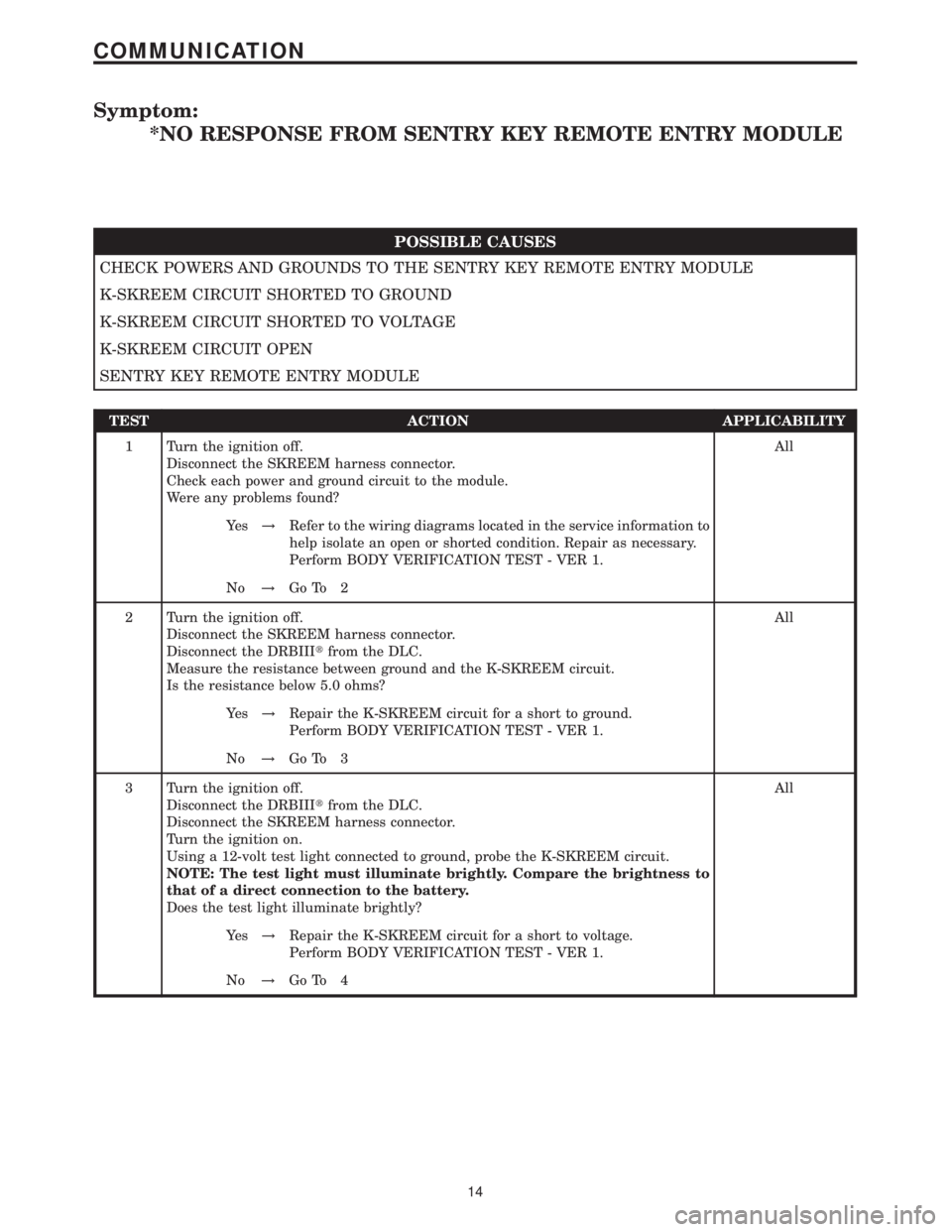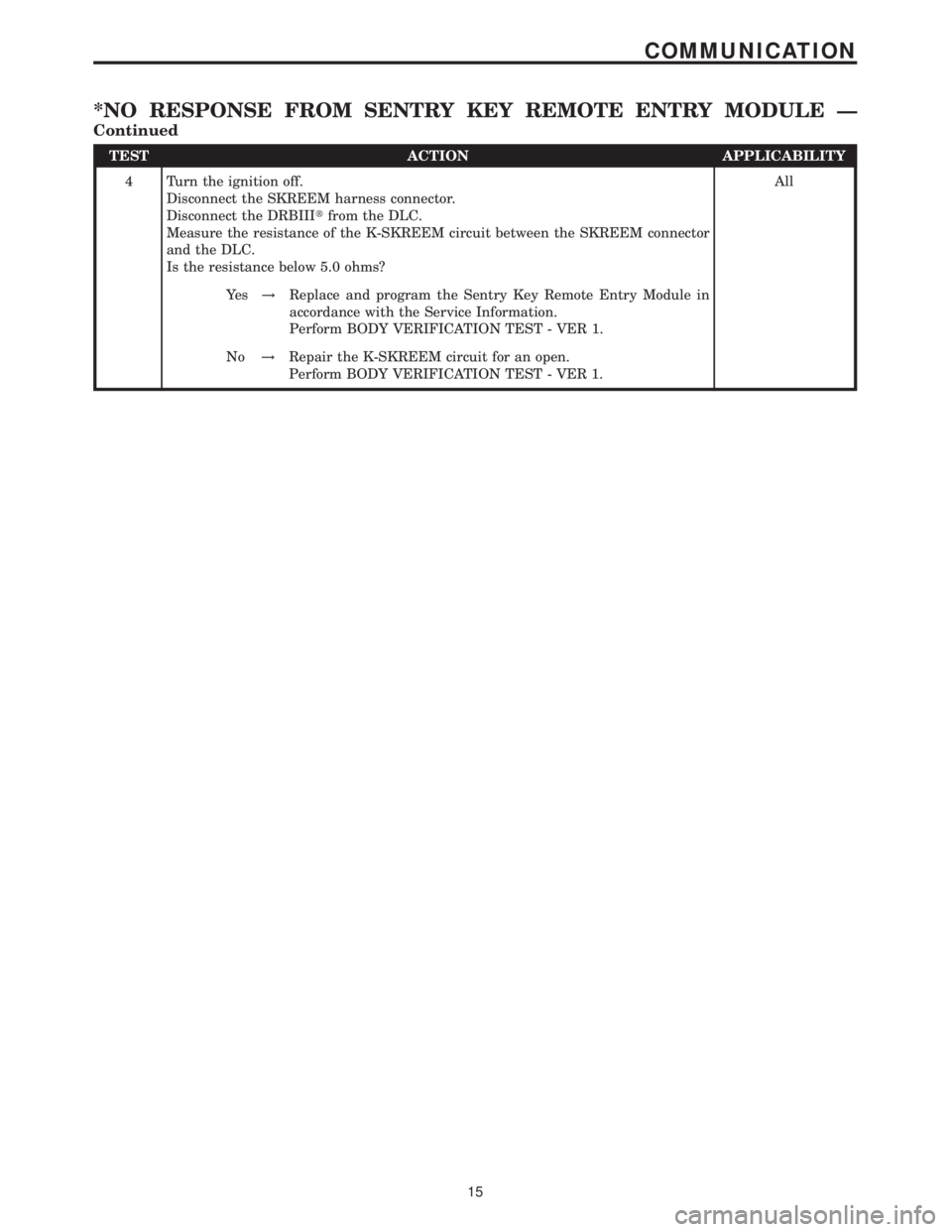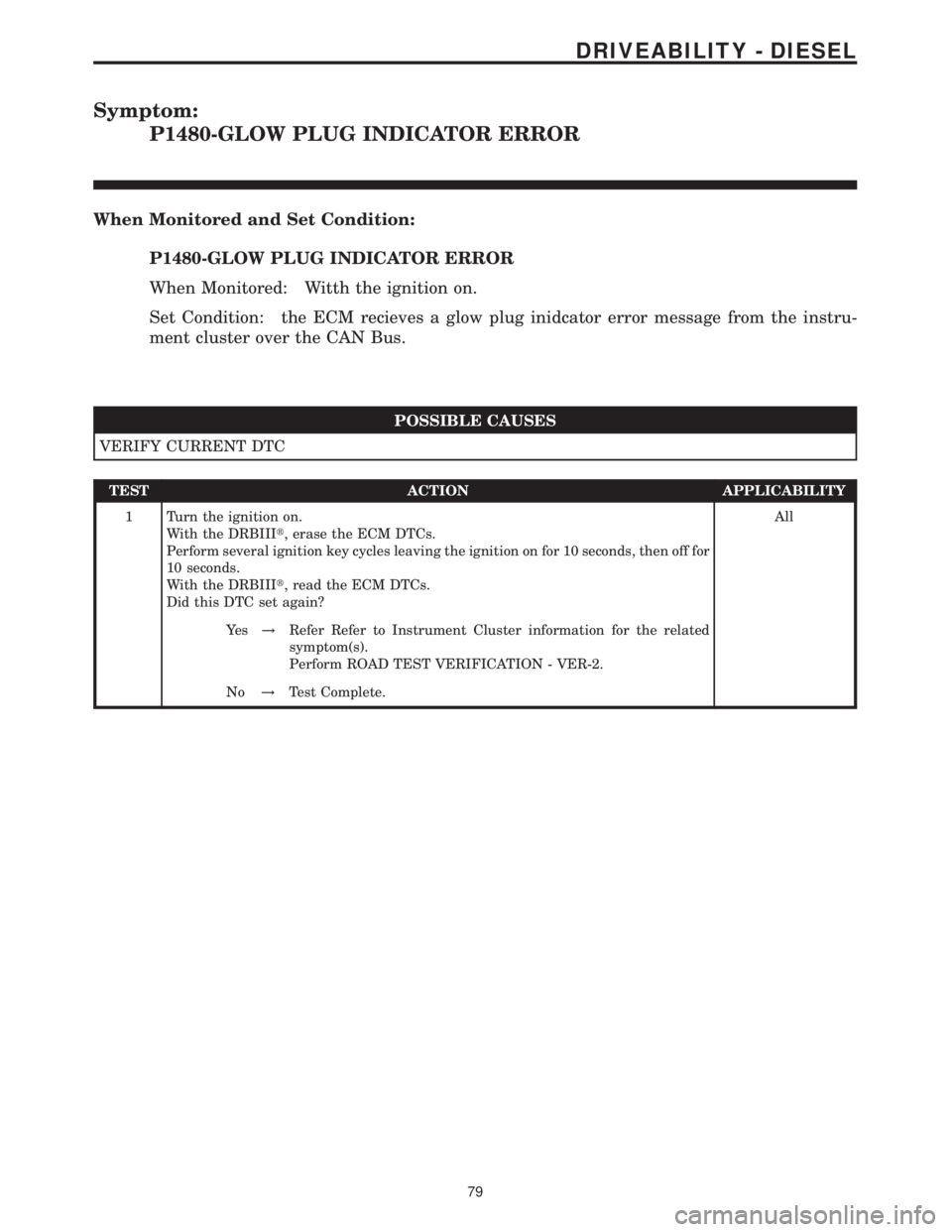2006 MERCEDES-BENZ SPRINTER key
[x] Cancel search: keyPage 426 of 2305

3.2.6 SKREEM OPERATION
When ignition power is supplied to the SKREEM,
the SKREEM performs an internal self-test. After
the self-test is complete, the SKREEM energizes
the antenna (this activates the transponder chip)
and sends a challenge to the transponder chip. The
transponder chip responds to the challenge by gen-
erating an encrypted response message.
After responding to the coded message, the tran-
sponder sends a transponder ID message to the
SKREEM. The SKREEM compares the transpon-
der ID message to the available valid key codes in
SKREEM memory (8 key maximum at any one
time). After validating the ignition key the
SKREEM sends a CAN Bus message request to the
ECM, then waits for the ECM response. If the ECM
does not respond, the SKREEM will send the re-
quest again. If the ECM does not respond again, the
SKREEM will stop sending the request and store a
trouble code in memory. If the ECM sends a correct
response to the SKREEM, the SKREEM sends a
valid/invalid key message to the ECM. The ECM
will allow or disallow engine operation based on this
message.
Secret Key - an electronically stored value (iden-
tification number) that is unique to each SKREEM.
The secret key is stored in the SKREEM, ECM and
all ignition key transponders.
Challenge - a random number that is generated by
the SKREEM at each ignition key cycle.
The secret key and challenge are the two vari-
ables used in the algorithm that produces the
encrypted response message. The transponder uses
the crypto algorithm to receive, decode and respond
to the message sent by the SKREEM. After re-
sponding to the coded message, the transponder
sends a transponder ID message to the SKREEM.
3.3 DIAGNOSTIC TROUBLE CODES
Each diagnostic trouble code (DTC) is diagnosed
by following a specific procedure. The diagnostic
test procedure contains step-by-step instruction for
determining the cause of the DTC as well as no
trouble code problems. It is not necessary to per-
form all of the tests in this book to diagnose an
individual code.
Always begin diagnosis by reading the DTCs
using the DRBIIIt. This will direct you to the
specific test(s) that must be performed.
3.3.1 HARD CODE
A DTC that comes back within one cycle of the
ignition key is a hard code. This means that the
problem is current every time the ECM/SKREEM
checks that circuit or function. Procedures in this
manual verify if the DTC is a hard code at thebeginning of each test. When the fault is not a hard
code, an intermittent test must be performed.
NOTE: If the DRBIIITdisplays faults for
multiple components (i.e. ECT, MAF, IAT
sensors) identify and check the shared
circuits for possible problems before
continuing (i.e. sensor grounds or 5-volt
supply circuits). Refer to the appropriate
schematic to identify shared circuits.
3.3.2 INTERMITTENT CODE
A DTC that is not current every time the ECM/
SKREEM checks the circuit or function is an inter-
mittent code. Most intermittent DTCs are caused
by wiring or connector problems. Problems that
come and go like this are the most difficult to
diagnose; they must be looked for under specific
conditions that cause them. The following checks
may assist you in identifying a possible intermit-
tent problem.
± Visually inspect the related wire harness con-
nectors. Look for broken, bent, pushed out or
corroded terminals.
± Visually inspect the related wire harness.
Look for chafed, pierced or partially broken
wire.
± Refer to hotlines or technical service bulletins
that may apply.
NOTE: Electromagnetic (radio) interference
can cause an intermittent system
malfunction. This interference can interrupt
communication between the ignition key
transponder and the SKREEM.
3.3.3 ECM DIAGNOSTIC TROUBLE CODES
IMPORTANT NOTE: Before replacing the
ECM for a failed driver, control circuit or
ground circuit, be sure to check the related
component/circuit integrity for failures not
detected due to a double fault in the circuit.
Most ECM driver/control circuit failures are
caused by internal failures to components
(i.e. relays and solenoids) and shorted
circuits (i.e. sensor pull-ups, drivers and
ground circuits). These faults are difficult to
detect when a double fault has occurred and
only one DTC has set.
If the DRBIIItdisplays faults for multiple com-
ponents (i.e. MAF, ECT, ENG OIL, etc.), identify
and check the shared circuits for possible problems
before continuing (i.e. sensor grounds or 5-volt
3
GENERAL INFORMATION
Page 433 of 2305

ohmmeter
voltmeter
jumper wires and probes
oscilloscope
6.0 GLOSSARY OF TERMS
A/Cair conditioning
APPaccelerator pedal position (sensor)
BCMbody control module
BPboost pressure (sensor)
CKPcrankshaft position (sensor)
CMPcamshaft position (sensor)
CTMcentral timer module
DLCdata link connector
ECMengine control module
ECTengine coolant temperature (sensor)
EGRexhaust gas recirculation (solenoid/
valve)
EOSengine oil sensor
IATintake air temperature (sensor)
IPintake pressure sensorMAFmass air flow (sensor)
MILmalfunction indicator lamp
msmillisecond(s)
O2oxygen sensor
PDCpower distribution center
S/Cspeed control
SKREEMsentry key remote entry module
SRCsignal range check
WIFwater in fuel (sensor)
10
GENERAL INFORMATION
Page 437 of 2305

Symptom:
*NO RESPONSE FROM SENTRY KEY REMOTE ENTRY MODULE
POSSIBLE CAUSES
CHECK POWERS AND GROUNDS TO THE SENTRY KEY REMOTE ENTRY MODULE
K-SKREEM CIRCUIT SHORTED TO GROUND
K-SKREEM CIRCUIT SHORTED TO VOLTAGE
K-SKREEM CIRCUIT OPEN
SENTRY KEY REMOTE ENTRY MODULE
TEST ACTION APPLICABILITY
1 Turn the ignition off.
Disconnect the SKREEM harness connector.
Check each power and ground circuit to the module.
Were any problems found?All
Ye s!Refer to the wiring diagrams located in the service information to
help isolate an open or shorted condition. Repair as necessary.
Perform BODY VERIFICATION TEST - VER 1.
No!Go To 2
2 Turn the ignition off.
Disconnect the SKREEM harness connector.
Disconnect the DRBIIItfrom the DLC.
Measure the resistance between ground and the K-SKREEM circuit.
Is the resistance below 5.0 ohms?All
Ye s!Repair the K-SKREEM circuit for a short to ground.
Perform BODY VERIFICATION TEST - VER 1.
No!Go To 3
3 Turn the ignition off.
Disconnect the DRBIIItfrom the DLC.
Disconnect the SKREEM harness connector.
Turn the ignition on.
Using a 12-volt test light connected to ground, probe the K-SKREEM circuit.
NOTE: The test light must illuminate brightly. Compare the brightness to
that of a direct connection to the battery.
Does the test light illuminate brightly?All
Ye s!Repair the K-SKREEM circuit for a short to voltage.
Perform BODY VERIFICATION TEST - VER 1.
No!Go To 4
14
COMMUNICATION
Page 438 of 2305

TEST ACTION APPLICABILITY
4 Turn the ignition off.
Disconnect the SKREEM harness connector.
Disconnect the DRBIIItfrom the DLC.
Measure the resistance of the K-SKREEM circuit between the SKREEM connector
and the DLC.
Is the resistance below 5.0 ohms?All
Ye s!Replace and program the Sentry Key Remote Entry Module in
accordance with the Service Information.
Perform BODY VERIFICATION TEST - VER 1.
No!Repair the K-SKREEM circuit for an open.
Perform BODY VERIFICATION TEST - VER 1.
15
COMMUNICATION
*NO RESPONSE FROM SENTRY KEY REMOTE ENTRY MODULE Ð
Continued
Page 451 of 2305

Symptom:
P0105-INTAKE PRESSURE SENSOR SIGNAL VOLTAGE TOO HIGH
When Monitored and Set Condition:
P0105-INTAKE PRESSURE SENSOR SIGNAL VOLTAGE TOO HIGH
When Monitored: With the ignition on.
Set Condition: Intake Pressure Sensor Signal voltage is 4.9 volts or greater.
POSSIBLE CAUSES
INTERMITTENT CONDITION
INTAKE PRESSURE SENSOR GROUND CIRCUIT SHORTED TO VOLTAGE
INTAKE PRESSURE SENSOR SIGNAL CIRCUIT SHORTED TO VOLTAGE
INTAKE PRESSURE SENSOR GROUND CIRCUIT OPEN
INTAKE PRESSURE SENSOR
POOR CONNECTOR TERMINAL CONTACT
ENGINE CONTROL MODULE (INTERNAL)
ENGINE CONTROL MODULE (SENSOR SIGNAL SHORTED TO VOLTAGE)
TEST ACTION APPLICABILITY
1NOTE: If the ECM detects and stores a DTC, the ECM also stores the
engine/vehicle operating conditions under which the DTC was set. Some of
these conditions are displayed on the DRB at the same time the DTC is
displayed.
NOTE: If DTC P1611, P2306 or P2332 is present with this DTC, diagnose
DTCs P1611, P2306 or P2332 before diagnosing this DTC.
NOTE: Before erasing stored DTCs, record these conditions. Attempting to
duplicate these conditions may assist when checking for an active DTC.
NOTE: Ensure all turbocharger inlet and outlet tubes are connected prop-
erly, without damage and restriction before continuing with this test. Also
ensure the boost pressure servo motor and servo rod are attached and
functioning properly.
NOTE: If a Boost Pressure Servo Motor DTC is present with this DTC,
diagnose that DTC before continuing.
Turn the ignition on.
With the DRB, erase ECM DTCs.
Cycle the ignition key on and off several times, leaving the key on for at least 10
seconds at a time.
With the DRB, read ECM DTCs.
Did this DTC set again?All
Ye s!Go To 2
No!Go To 8
28
DRIVEABILITY - DIESEL
Page 477 of 2305

TEST ACTION APPLICABILITY
1WARNING: THE FUEL INJECTION PUMP SUPPLIES HIGH-PRESSURE
FUEL TO EACH INDIVIDUAL INJECTOR THROUGH HIGH-PRESSURE
FUEL LINES. FUEL UNDER HIGH PRESSURE CAN PENETRATE SKIN
AND CAUSE PERSONAL INJURY. WEAR SAFETY GOGGLES AND ADE-
QUATE PROTECTIVE CLOTHING.
NOTE: If DTC P1611, P2306 or P2332 is present with this DTC, diagnose
DTCs P1611, P2306 or P2332 before diagnosing this DTC.
NOTE: If the ECM detects and stores a DTC, the ECM also stores the
engine/vehicle operating conditions under which the DTC was set. Some of
these conditions are displayed on the DRB at the same time the DTC is
displayed.
NOTE: Before erasing stored DTCs, record these conditions. Attempting to
duplicate these conditions may assist when checking for an active DTC.
Turn the ignition on.
With the DRB, erase ECM DTCs.
Cycle the ignition key on and off several times, leaving the key on for at least 10
seconds at a time.
With the DRB, read ECM DTCs.
Did this DTC set again?All
Ye s!Go To 2
No!Go To 10
2 Turn the ignition off.
Disconnect the Fuel Pressure Sensor harness connector.
Turn the ignition on.
Measure the voltage of the Fuel Pressure Sensor Signal circuit.
Select the appropriate voltage reading.All
Voltage is above 5.4 volts.
Go To 3
Voltage is between 4.7 and 5.4 volts.
Go To 4
Voltage is below 4.7 volts.
Go To 9
3 Turn the ignition off.
Disconnect the Fuel Pressure Sensor harness connector.
Disconnect the ECM harness connectors.
Remove the Engine Control Relay.
Connect a jumper wire between cavity 30 and cavity 87 of the Engine Control Relay
connector.
Turn the ignition on.
Measure the voltage of the Fuel Pressure Sensor Signal circuit.
Is the voltage below 1.0 volt?All
Ye s!Replace and program the Engine Control Module in accordance
with the Service Information.
Perform ROAD TEST VERIFICATION - VER-2.
No!Repair the Fuel Pressure Sensor Signal circuit for a short to
voltage.
Perform ROAD TEST VERIFICATION - VER-2.
54
DRIVEABILITY - DIESEL
P0190-FUEL PRESS SENSOR CIRCUIT MALF SIGNAL VOLTAGE TOO
HIGH Ð
Continued
Page 480 of 2305

Symptom List:
P0190-FUEL PRESS SENSOR CIRCUIT MALF SIGNAL VOLTAGE
TOO LOW
P2008-FUEL PRESSURE SENSOR CIRCUIT SIGNAL VOLTAGE
TOO LOW
Test Note: All symptoms listed above are diagnosed using the same tests.
The title for the tests will be P0190-FUEL PRESS SENSOR
CIRCUIT MALF SIGNAL VOLTAGE TOO LOW.
When Monitored and Set Condition:
P0190-FUEL PRESS SENSOR CIRCUIT MALF SIGNAL VOLTAGE TOO LOW
When Monitored: With the ignition on.
Set Condition: The Fuel Rail Pressure Sensor Signal voltage is below 0.2 volt.
POSSIBLE CAUSES
FUEL PRESSURE SENSOR
INTERMITTENT CONDITION
FUEL PRESSURE SENSOR SIGNAL CIRCUIT SHORTED TO GROUND
FUEL PRESSURE SENSOR SIGNAL CIRCUIT SHORTED TO SENSOR GROUND
ECM - FUEL PRESSURE SENSOR SIGNAL SHORTED TO GROUND
TEST ACTION APPLICABILITY
1WARNING: THE FUEL INJECTION PUMP SUPPLIES HIGH-PRESSURE
FUEL TO EACH INDIVIDUAL INJECTOR THROUGH HIGH-PRESSURE
FUEL LINES. FUEL UNDER HIGH PRESSURE CAN PENETRATE SKIN
AND CAUSE PERSONAL INJURY. WEAR SAFETY GOGGLES AND ADE-
QUATE PROTECTIVE CLOTHING.
NOTE: If DTC P1611, P2306 or P2332 is present with this DTC, diagnose
DTCs P1611, P2306 or P2332 before diagnosing this DTC.
NOTE: If the ECM detects and stores a DTC, the ECM also stores the
engine/vehicle operating conditions under which the DTC was set. Some of
these conditions are displayed on the DRB at the same time the DTC is
displayed.
NOTE: Before erasing stored DTCs, record these conditions. Attempting to
duplicate these conditions may assist when checking for an active DTC.
Turn the ignition on.
With the DRB, erase ECM DTCs.
Cycle the ignition key on and off several times, leaving the key on for at least 10
seconds at a time.
With the DRB, read ECM DTCs.
Did this DTC set again?All
Ye s!Go To 2
No!Go To 6
57
DRIVEABILITY - DIESEL
Page 502 of 2305

Symptom:
P1480-GLOW PLUG INDICATOR ERROR
When Monitored and Set Condition:
P1480-GLOW PLUG INDICATOR ERROR
When Monitored: Witth the ignition on.
Set Condition: the ECM recieves a glow plug inidcator error message from the instru-
ment cluster over the CAN Bus.
POSSIBLE CAUSES
VERIFY CURRENT DTC
TEST ACTION APPLICABILITY
1 Turn the ignition on.
With the DRBIIIt, erase the ECM DTCs.
Perform several ignition key cycles leaving the ignition on for 10 seconds, then off for
10 seconds.
With the DRBIIIt, read the ECM DTCs.
Did this DTC set again?All
Ye s!Refer Refer to Instrument Cluster information for the related
symptom(s).
Perform ROAD TEST VERIFICATION - VER-2.
No!Test Complete.
79
DRIVEABILITY - DIESEL